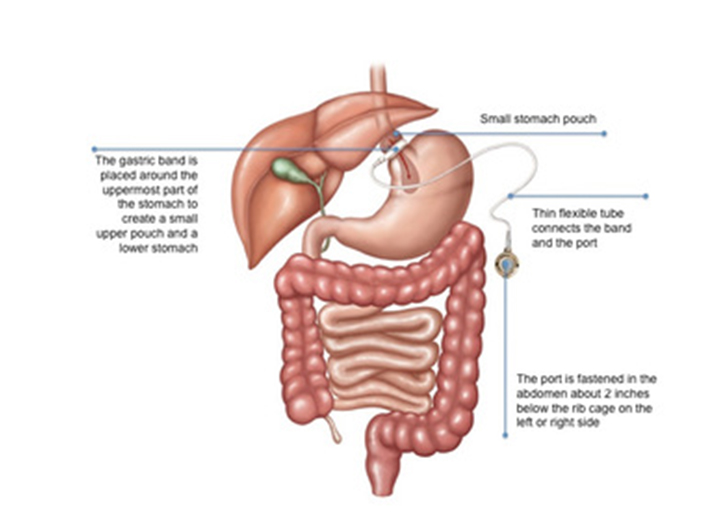Laparoscopic Adjustable Gastric Banding, commonly referred to as Lap Band surgery, is a type of minimally invasive weight loss surgery (bariatric surgery) that involves wrapping a band around a part of the stomach to reduce its size and limit the capacity of food intake.
The band used for the surgery is an adjustable, inflatable silicone ring which is placed around the stomach to divide it into 2 parts: a small, upper pouch and a larger, lower pouch. The upper pouch, being smaller, fills up quickly with food giving a feeling of fullness or satiety. This limits excessive intake of food and promotes weight loss. The Lap-Band surgery is a restrictive weight loss surgery and does not involve cutting or stapling of the stomach as do other bariatric surgeries.
Indications
As per IFSO-APC Consensus statements 2011.
- Bariatric surgery should be considered for the treatment of obesity for acceptable Asian candidates with BMI ≥ 35 with or without co-morbidities.
- Bariatric/GI metabolic surgery should be considered for the treatment of T2DM or metabolic syndrome for patients who are inadequately controlled by lifestyle alternations and medical treatment for acceptable Asian candidates with BMI ≥ 30
- The surgical approach may be considered as a non-primary alternative to treat inadequately controlled T2DM, or metabolic syndrome, for suitable Asian candidates with BMI ≥ 27.5.
Contraindications
Lap-Band surgery is contraindicated or not recommended in patients with:
Laparoscopic Adjustable Gastric Banding, commonly referred to as Lap Band surgery, is a type of minimally invasive weight loss surgery (bariatric surgery) that involves wrapping a band around a part of the stomach to reduce its size and limit the capacity of food intake.
The band used for the surgery is an adjustable, inflatable silicone ring which is placed around the stomach to divide it into 2 parts: a small, upper pouch and a larger, lower pouch. The upper pouch, being smaller, fills up quickly with food giving a feeling of fullness or satiety. This limits excessive intake of food and promotes weight loss. The Lap-Band surgery is a restrictive weight loss surgery and does not involve cutting or stapling of the stomach as do other bariatric surgeries.
Surgical procedure
Lap-Band surgery is performed laparoscopically under general anaesthesia. Your surgeon makes a few small incisions in the abdominal wall and inserts a laparoscope, a lighted fibre optic tube with a camera attached to its end, into one incision. Small surgical instruments are inserted through the other incisions. Your surgeon will be able to see the internal structures of the abdomen on a monitor with images sent from the camera.
The band is placed around the upper part of the stomach to divide it into two sections: a smaller, upper pouch and a larger, lower pouch. The band is then secured and fastened with sutures. The band is inflated with sterile saline until it attains the correct diameter to optimally constrict the stomach. In order to adjust the band, an access port connected to the band is placed under the skin of the abdomen. This enables your surgeon to loosen (deflate) or tighten (inflate) the band by injecting or aspirating saline solution as needed. Finally, the incisions are closed.
Post-surgical care
After the surgery, you are required to stay in the hospital for about 2-3 days. You will be given pain medications to keep you comfortable. Your nurse will help you to move at the earliest after the surgery to prevent blood clots, respiratory problems and bedsores. To check if the lap-band is in appropriate position an X-ray of your stomach will be advised a day after the surgery. You will be kept on a liquid diet for the first 2 weeks. Your surgeon or dietician will give you a specific diet plan and instructions to follow after the surgery. It is important to drink plenty of fluids throughout the day to avoid dehydration.
Advantages
Lap band surgery has advantages over other weight loss surgeries including:
- Safer and less invasive procedure
- Fewer complications
- Quicker recovery
- Shorter hospital stay
- Ability to adjust the band for customizing weight loss
- Ability to reverse the surgery
- No stapling or cutting of the stomach or re-routing of intestines
Risks and complications
As with any major surgical procedure, Lap band surgery also carries some risks to the patient.
The common risks and complications associated with lap-band surgery include:
- Internal bleeding
- Infection
- Nausea and vomiting
- Band slippage or deflation
- Oesophageal dilation
- Erosion of stomach
- Obstruction of stomach
- Irreversible damage to stomach requiring surgery


